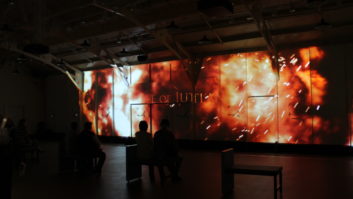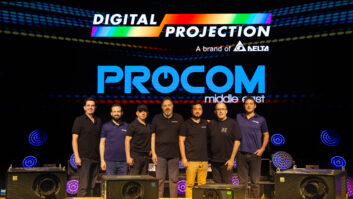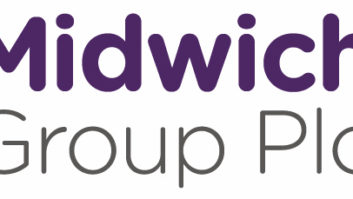
At IBC (the International Broadcast Convention) last year, all the talk was of 4K – so-called Ultra HD resolution with four times as many pixels as today’s Full HD. At CES (the Consumer Electronics Show) in January, all the talk was of 4K. And at ISE? Well, it would be an exaggeration to say that no-one talked of anything else – but Planar had an 84in 4K display, and Sony was showcasing 4K in both a projector (the VPL-VW1000ES) and an LCD screen (the Bravia FWD-84X9005). Gefen unveiled new switchers/matrices that support 4K. coolux showed 4K playout on its Pandoras Box show control system.
It seems as if 4K is coming – so much so that a senior BBC executive has been quoted as saying that everyone accepts that 3D is dead so far as TV is concerned, and 4K is the future. According to reports, the BBC is filming the next series of its Survival wildlife programme in 4K.
Strange, then, that in an interview with TrustedReviews, Panasonic’s senior manager for TV said that broadcasters weren’t keen on investing in the new standard, noting that “you can’t even talk to [the BBC] about 4K”.
The biggest challenge
The key word is “investing”. It’s not just about screens – it’s about what it takes to capture, edit and transmit four times as much picture information. Of these, transmission may be the biggest challenge in a networking world that faces a continual struggle to provide all the bandwidth everyone needs – while delivering video of ever-higher quality. According to Frost & Sullivan, 2013 will see 65% of available internet bandwidth consumed by video.
And that’s where HEVC – High Efficiency Video Coding – comes in. Also known as H.265, it is the next step forward from the H.264 codec (also known as MPEG-4 Part 10/AVC for Advanced Video Coding) that is widely employed today: in fact, according to the ITU – the International Telecommunications Union, the body behind the new standard – H.264 is the codec that supports 80% of all internet video traffic.
Put simply, HEVC will be around twice (estimates vary) as efficient as H.264, and four times as efficient as MPEG-2 – meaning that transmitted video quality can be maintained but only half the bandwidth required by H.264 used, or video quality can be improved but using the same bandwidth as before. Without this higher level of compression, it’s hard to believe that 4K video transmission will be possible – making 4K displays irrelevant.
“HEVC will be an evolution, not a revolution,” smiles Mike Allan, chief technology officer at Exterity. “In the same way as H.264 was necessary to allow broadcasters to deliver content in HD, so HEVC will allow them to do so in Ultra HD.”
It’s tempting to believe, under the circumstances, that HEVC will sweep all before it – and that market domination is likely to happen sooner rather than later. However, the first thing to understand is that, while it has been under development since 2004, the final draft of the standard was only agreed by ITU members on 25 January this year. And, while there have been several product announcements since Ericsson launched the SVP5500, which was described as the world’s first HEVC encoder, at IBC 2012, HEVC still has a long way to go before it can be considered mainstream.
What the excitement about HEVC has done, however, is to re-focus the attention of the industry on the vital role that codecs play across a broad range of applications – videoconferencing, digital signage, security systems and IPTV are just a few.
Codec choices
“Ideally, compression technologies aim to preserve the original image detail with high quality; to maintain natural, real-time motion; and to produce little or no delay for real-time operations,” says Jean-Baptiste Lorent, product manager at Belgian image technology company intoPIX. “Codecs are always a compromise between complexity, image quality, bit rate or latency.”
Latency – in video distribution, the delay between transmission and reception of an image caused by extensive processing of the captured image – is often overlooked in assessing the suitability of a codec. For real-time applications, however, it is a key parameter.
“Selecting an encoder is about more than just the codec [the encoding core] and its quality level [profile],” notes Peter Maag, chief marketing officer at Haivision. “Encoders are designed for different applications – enterprise, OTT, broadcast and so on. Selection is a matter of defining the class of encoder for the application, then determining the price/performance required in consideration of the network and bandwidth. For internet streaming, high-profile H.264 with ‘b’ frames will optimise the bandwidth, for example, across RTMP uplinks. For enterprise applications, a main profile encoder emitting high-performance H.264 over a transport stream is typical. Once the application is understood and the codec type is defined, the range of selection narrows, and one can really focus on other factors such as price, quality and reliability.”
“When it comes to video, higher quality usually means higher bandwidth,” says Jeff Hastings, chief executive officer of BrightSign, “but workflow is also important. In an environment where the bandwidth isn’t a consideration, using a lossless codec that results in very large files is quite acceptable. If you want to use that same file on a set-top box at the end of a slow internet connection, or make it available via the web, a codec that compresses the file – and that will likely reduce its quality – to an acceptable level is a requirement.”
“For the digital signage market, it’s set-top box and embedded PC chip vendors who drive endpoint decoding, while software tools and cameras drive encoding,” he continues. “The best codec choice would be natively output from the software package or camera you are using for content creation that is also played natively on the end point. Minimising or eliminating transcoding between lossy codec types is the main goal.”
HEVC doesn’t answer all needs
While HEVC is designed primarily to make the best possible use of network bandwidth (if at the cost of some degradation of image quality) it’s worth recalling that other codecs prioritise maintaining as much of the original picture information as possible, especially in environments where bandwidth is less of a constraint.
“JPEG 2000 will stay very important in cinema, broadcast and markets where image is a crucial asset,” notes Lorent. “HEVC answers a very specific need – but not all needs. The future of the wavelet-based JPEG 2000 codec is bright as it gives the user superior control and flexibility of the image processing chain. The codec requires less power, less space in hardware implementations and generally delivers greater scalability, flexibility and visual quality than any other codec.”
Lorent refers to another parameter in determining codec choice. As well as image quality, bandwidth availability, latency and workflow, the amount of processing power needed is also an important consideration. At least one expert estimate believes that HEVC will require 10 times the computing capability of H.264 at the encoding end.
The last mile
“HEVC definitely requires more computing horsepower, just as H.264 required three times the horsepower of MPEG-2,” says Maag. “That is why systems will be expensive early on, limiting the adoption. Early encoding systems will certainly be software based.”
“HEVC will impact conferencing and last-mile streaming – including OTT/IPTV – but other applications will use H.264 for many years until the higher-quality chip technology is firmly established,” he continues. “The pro-AV market will only be affected in the conferencing aspect, and digital signage will be unaffected except in the ability to decode HEVC once consumer delivery is established.”
“The extent to which HEVC can succeed will depend on the cost to manufacturers of implementing the newer codec,” adds RGB Communications’ chief technical officer David Webster. “Lowest cost products will no doubt continue to use the cheapest – that is, older – codec technology.”
It’s that ‘last mile’ that’s important. The significance of the Ericsson SVP5500 announced at IBC being specifically targeted at delivering live TV to mobile devices should not be underestimated.
“Smartphones are becoming more powerful, and capable of the processing HEVC needs,” notes Allan. “HEVC is likely to be more revolutionary in the mobile market as operators look to deliver more HD content to smartphones.” At ISE, Exterity announced an addition to its AvediaStream encoder family, which is designed for live streaming to mobile devices and digital signage integration.
Maag agrees that the mobile market is where HEVC will first become entrenched. That it will become significant throughout the market seems inevitable: the question is only one of timing.
“It’s possible that HEVC will become the dominant codec,” says Chris Chinnock, founder and president of display market analysts Insight Media, “but it will take many years and MPEG-2 and MPEG-4 will exist simultaneously for the foreseeable future.”
“Other codecs won’t just disappear once HEVC arrives,” agrees Exterity’s Allan. “Remember all the wireless vendors telling us that the technology would see the disappearance of wired networks? Well, it didn’t happen. In the same way, HEVC won’t totally displace what’s already out there.
“Silicon vendors will need a new IP block for their FPGAs, and they’re looking at an 18-month development cycle,” he continues. “I don’t have silicon vendors banging on my door telling me that they have HEVC silicon available. You need that technology to be readily available for integration into your products before something like HEVC can become a reality.
“I suspect it’ll be at least a couple of years before we see HEVC becoming mainstream,” he concludes. “2015-16 seem likely. We’re still very early in the evolution.”
Hastings sees silicon vendors somewhat ahead of where Allan believes them to be – but he sees similar timescales. “Software tools are available on the encode side already,” he says. “Many chip vendors have announced plans to release later this year. Broad deployments will start to show up in two to four years.”
Watching and waiting
Given those timescales, it’s no surprise that the AV industry is very much in a “wait and see” mode.
“It’s very much a chicken-and-egg situation,” says Webster. “Manufacturers won’t make equipment with the new HEVC standard unless they can sell it – and customers won’t buy into HEVC if there is no kit available for sale. Nonetheless, as end users become aware of the benefits and start to ask for HEVC-capable devices, we can expect manufacturers to respond with an ever-increasing range of products sooner rather than later. We will add HEVC-capable solutions to our portfolio as soon as our channel partners demand us to do so.”
“We’re watching with interest,” says Mike Cuckow, sales director EMEA/Asia Pacific at Cabletime, “because it will definitely have benefits for IPTV, and we’ll be assessing its potential impact on customer requirements.”
“I’m aware of HEVC, of course, as most in the VC industry should be,” says Andy Wright, managing director of Video Corporation, which distributes Radvision and Vidyo videoconferencing systems in the UK, “and of its potential benefits and downsides – but it’s too far away to worry about it now. I do know that both our vendors are treating HEVC very seriously, though, and are actively driving the standard and its eventual adoption because of the benefits it will bring.”
As Maag points out, there is substantial hype around HEVC – and separating the hype from the reality is something of a challenge. That said: the advent of 4K resolution seems inevitable – and HEVC is a key enabling technology. There is, however, a substantial industry infrastructure and investment in other codecs: this, and the fact that codecs such as JPEG 2000 are designed to achieve different goals, means that those other codecs will persist for some time. But HEVC will become pervasive: the only question is when – and for how long.
“In the last decade, we have multiplied by 40 the quantity of data that represents an image,” notes Lorent. “The next two decades could well see that number becoming 200.”
It’s not even with us yet, but already, HEVC’s obsolescence seems guaranteed.
www.brightsign.biz
www.cabletime.com
www.displaydaily.com
www.exterity.com
www.haivision.com
www.intopix.com
www.rgbcomms.co.uk
www.teracue.com
www.videocorporation.com







